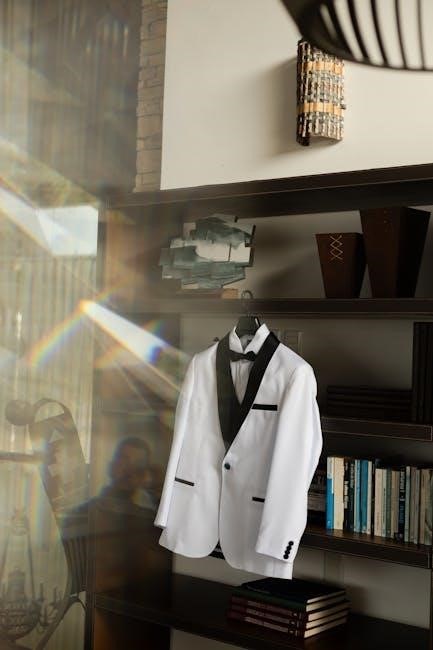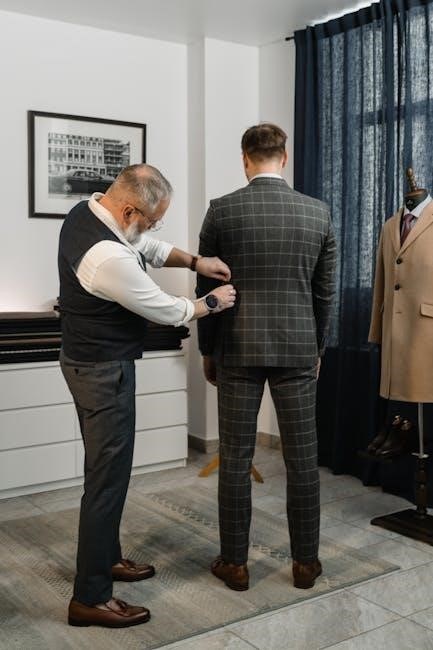A well-fitted suit jacket enhances confidence and professionalism, making it essential to understand sizing. Proper fit balances comfort and style, ensuring a polished appearance for any occasion.
Why Proper Fit Matters

A proper fit is crucial for both style and comfort. A well-tailored suit jacket enhances confidence, creating a polished, professional appearance. Ill-fitting jackets can look boxy or overly tight, detracting from a put-together look. Proper fit ensures freedom of movement while maintaining a streamlined silhouette. Shoulder fit is particularly important, as it sets the foundation for the jacket’s overall appearance. A jacket that hugs the shoulders correctly avoids the unflattering “80s football pads” look. Additionally, accurate sizing ensures the chest and sleeves align proportionally, creating a balanced, flattering shape. Investing in the right fit elevates your style, making you appear taller, slimmer, or more muscular, depending on your body type. Proper fit is not just about aesthetics—it’s about feeling confident and comfortable in your clothing.
Understanding Suit Jacket Size Charts
Suit jacket size charts are essential tools for determining the right fit. They typically feature numerical or alpha sizing (S, M, L, XL) and provide measurements for chest, shoulders, and sleeve length. To use a size chart effectively, measure yourself accurately, focusing on the chest circumference, as it often determines the jacket size. For example, a 40-inch chest usually corresponds to a size 40 jacket. Some charts may also include body length and shoulder measurements. Understanding these elements helps match your measurements to the correct size. Different brands may have slight variations, so it’s important to consult the specific chart for the brand you’re purchasing. This ensures a fit that balances comfort and style, avoiding both restrictive and overly loose garments.

How to Measure Yourself for a Suit Jacket
Measure your chest, shoulders, sleeve length, and body length using a flexible tape measure. Ensure accurate readings to match your dimensions with the size chart perfectly.
Measuring Chest Size
To measure your chest size accurately for a suit jacket, wrap a flexible tape measure around the fullest part of your chest, typically under the armpits and across the shoulder blades. Keep the tape measure level and parallel to the floor, ensuring it’s neither too tight nor too loose. Stand up straight with your arms at your sides and take a normal breath to ensure a natural measurement. If you’re measuring over clothing, wear a thin shirt to maintain accuracy. The chest measurement corresponds to the jacket size, so if your chest measures 40 inches, look for a 40-inch jacket. Consider fit types like slim or regular when selecting your size. If between sizes, consider trying both or consulting the size chart for guidance; For the most accurate fit, measure bare skin or over a thin layer.
Measuring Shoulder Width
To measure shoulder width for a suit jacket, place the tape measure across the back of your shoulders, starting from the tip of one shoulder and ending at the tip of the other. Ensure the tape measure is level and parallel to the floor. Stand up straight with your arms at your sides and avoid slouching. The measurement should span the widest part of your shoulders, just above the shoulder blades. This measurement helps determine the jacket’s shoulder fit, which is crucial for a tailored look. For accurate results, measure over a shirt or light layer. Proper shoulder width ensures the jacket sits comfortably without pulling or sagging. Record this measurement carefully, as it directly impacts the fit of the jacket. Keep the tape measure snug but not overly tight for the best results.
Measuring Sleeve Length

To measure sleeve length for a suit jacket, stand straight and place the tape measure at the center back of your neck. Run the tape over your shoulder, down to your elbow, and end at the desired jacket cuff length. Keep your arm relaxed at your side and slightly bent. The tape should follow the natural curve of your arm. Measure to the point where you want the cuff to sit, typically just past the wrist bone. Ensure the tape is not too tight or too loose. This measurement ensures sleeves are neither too short nor too long, providing a balanced fit. Accurate sleeve length is crucial for both comfort and style, as it affects the jacket’s overall proportions and appearance. Record this measurement precisely for the best fit. Sleeve length should align with your body’s natural dimensions for a tailored look.
Measuring Body Length
To measure the body length for a suit jacket, begin by standing upright and placing the tape measure at the base of the neck, aligning it with the spine. Gently run the tape down the back, following the natural curve of the body, and end the measurement at the desired jacket length. For most jackets, this point is typically at the hip bone or slightly lower, depending on the style. Ensure the tape is neither too tight nor too loose, allowing for a natural fit. This measurement is crucial as it determines how the jacket sits on the torso, ensuring proper proportions and comfort. Accurate body length ensures the jacket complements your posture and style, providing a tailored appearance. Record this measurement carefully to match with size charts for the best fit.

Key Considerations for Jacket Fit
A proper fit ensures balance, comfort, and style. The jacket should align with your posture, allowing ease of movement while maintaining a streamlined appearance. Confidence starts with precision.
Importance of Shoulder Fit
Shoulder fit is a cornerstone of a well-tailored suit jacket. The shoulder pads should align perfectly with your natural shoulder line, neither extending beyond nor falling short of it. Proper shoulder fit ensures the jacket drapes smoothly across the torso, maintaining a balanced silhouette. If the shoulders are too tight, the jacket may feel restrictive and pull across the chest. Conversely, overly broad shoulders can create a boxy, unflattering appearance. Achieving the right fit requires precise measurements and an understanding of how the jacket is constructed. Even slight deviations can dramatically alter the overall aesthetic and comfort. Ensuring accurate shoulder measurements is essential for a polished, professional look.
How Chest Size Relates to Jacket Size

Chest size is a primary measurement for determining suit jacket size, as it directly impacts the fit across the torso. The chest measurement is taken around the broadest part of the chest, typically just under the armpits. This measurement corresponds to the jacket’s interior space, ensuring comfort and a flattering silhouette. Jacket sizes are often based on this chest dimension, with additional considerations for shoulder width and body length. A well-fitted jacket should button smoothly without strain, indicating proper alignment with the chest size. Variations in fit (slim, regular, or classic) also influence how chest size translates to jacket size. Proper tailoring ensures the jacket complements the body proportionally, balancing aesthetics and functionality. Always cross-reference chest measurements with other dimensions for accuracy.
Understanding Sleeve Length and Fit
Sleeve length is a critical factor in achieving a polished look with a suit jacket. Properly fitted sleeves should extend to the base of the thumb, ensuring balance with the overall jacket length. Measurement begins at the center back of the neck, extending over the shoulder to the wrist. Sleeve length varies based on jacket style, with slim-fit jackets featuring shorter sleeves and classic fits offering longer ones. Ill-fitting sleeves can disrupt the jacket’s proportions, making it essential to align sleeve length with body measurements. Correct sleeve fit ensures comfort and a tailored appearance, enhancing the jacket’s aesthetic appeal and functionality. Always verify sleeve length against body measurements for optimal fit.

Body Length and Proportion
Body length and proportion are essential for a well-fitted suit jacket. Proper length ensures the jacket sits naturally on the torso, with the hem aligning with the hip or crotch, depending on the style. Measure from the base of the neck to the desired jacket length. Consider body type: longer torsos may need extended lengths, while shorter torsos suit shorter jackets. Proportionality is key; the jacket should balance with height and build. A balanced fit avoids boxiness or swamping, ensuring comfort and a tailored look. Choose styles that cater to your body type for optimal aesthetics and functionality.

How to Read a Suit Jacket Size Chart
Reading a suit jacket size chart involves matching your measurements to the chart’s numerical or alpha sizes, ensuring proper fit and style alignment. Always consider your chest size, shoulder width, and sleeve length to select the appropriate size. Pay attention to the fit style (slim, regular, or loose) as it affects measurements. If your measurements fall between sizes, consider your body type and personal comfort preferences. Use professional measurements if possible, and compare with well-fitting jackets you own. This ensures accuracy and the best fit for your suit jacket.

Interpreting Numerical Sizes
When reading a suit jacket size chart, numerical sizes typically correspond to your chest measurement in inches. For example, a size 36 generally fits a 36-inch chest. These sizes are standard across brands, but fit styles (slim, regular, loose) can vary. To interpret numerical sizes, match your chest measurement to the chart, ensuring alignment with your body type. Slim-fit jackets may require sizing up for comfort, while regular or classic fits offer a more relaxed cut. Always check if the chart includes shoulder and sleeve measurements, as these can influence fit. By comparing your measurements accurately, you can select the ideal numerical size for a well-fitting suit jacket. Proper interpretation ensures both comfort and style;
Understanding Alpha Sizing (S, M, L, XL)
Alpha sizing (S, M, L, XL) is a standardized method to categorize suit jacket sizes based on body measurements. These sizes are designed to simplify the fitting process, grouping similar measurements into broader categories. A size Small typically corresponds to chest measurements around 34-36 inches, Medium to 38-40 inches, Large to 42-44 inches, and Extra Large to 46-48 inches. However, variations exist between brands, as some may cut jackets slimmer or broader. Alpha sizing is less precise than numerical sizing but provides a quick reference. It’s essential to consider body type, as muscular builds or broader shoulders may require a larger size. Always check the brand’s specific size chart to ensure accuracy, as alpha sizing can differ slightly across manufacturers. Proper fit relies on matching your measurements to the brand’s alpha size range; This system offers convenience while maintaining a general fit guide for suit jackets. By aligning your chest and shoulder measurements with the alpha size chart, you can achieve a comfortable and stylish fit. Remember, alpha sizing is a starting point, and adjustments may be needed for perfect tailoring. Always prioritize how the jacket feels and looks on you, as fit is the ultimate goal.
How to Match Measurements to Sizes
To ensure a perfect fit, match your measurements to the corresponding size on the jacket size chart. Start by comparing your chest measurement to the chart, as this is the primary factor in determining size. Next, verify shoulder width, sleeve length, and body length against the size details. If your measurements fall between two sizes, consider your body type and the style of the jacket. For example, if you have broader shoulders, you may need a larger size. Always check the brand’s specific size chart, as sizing can vary. A well-fitting jacket should allow ease of movement while maintaining a streamlined appearance. If unsure, size up for comfort and tailoring adjustments. Matching measurements accurately ensures a tailored look and optimal comfort. Proper alignment of chest, shoulders, and sleeves is key to achieving the best fit. Always prioritize how the jacket drapes on your body, as this determines both style and functionality. By carefully matching your measurements to the size chart, you can select a jacket that flatters your physique and meets your sartorial needs.
Common Mistakes in Sizing
Overestimating chest size, ignoring shoulder fit, and not accounting for body type are frequent errors. Incorrect measurements often lead to ill-fitting jackets that lack comfort and style.
Overestimating or Underestimating Measurements
One of the most common errors when sizing a suit jacket is misjudging body measurements. Overestimating chest size can result in a boxy, ill-fitting jacket, while underestimating may lead to a restrictive fit. Many individuals incorrectly assume their size based on casual clothing, which often has more flexibility. To avoid this, use a flexible tape measure and take measurements while standing straight. Double-checking measurements ensures accuracy. Additionally, comparing your measurements to a well-fitting jacket can help verify size. Accurate sizing is crucial for a polished, professional look, as improper fit can ruin the jacket’s aesthetic and comfort. Always prioritize precise measurements for the best results.
Ignoring Shoulder Fit
Shoulder fit is a critical yet often overlooked aspect of suit jacket sizing. Ill-fitting shoulders can make a jacket look unprofessional, regardless of other measurements. If the shoulder pads extend beyond your natural shoulder line, the jacket will appear too large. Conversely, if the pads are too narrow, the jacket will seem too small. Proper shoulder fit ensures the jacket sits naturally, aligning with your body’s proportions. To avoid this mistake, always try on jackets and check the shoulder alignment. Don’t assume shoulder fit based on chest size alone, as body types vary. Ensuring correct shoulder fit is essential for a sharp, tailored appearance.
Not Considering Body Type
Body type plays a significant role in achieving the perfect suit jacket fit. Different body types—such as slim, athletic, or broader builds—require tailored approaches to sizing. For example, someone with a larger chest or midsection may need a slightly longer jacket to balance proportions, while a taller, slimmer individual might opt for a more streamlined cut; Ignoring body type can result in a jacket that appears too tight or overly boxy. It’s essential to choose styles that complement your natural shape, ensuring both comfort and a polished appearance. Always consider how your body type aligns with the jacket’s design to avoid a mismatched fit.

A well-fitting suit jacket enhances confidence and style. Always measure carefully, consider body type, and seek tailoring if needed for a flawless, personalized fit.
Ensuring the Best Fit
Achieving the best fit for a suit jacket requires attention to detail and a clear understanding of your measurements. Start by ensuring the jacket fits naturally when standing and sitting, with shoulders aligning perfectly. The chest should not feel restrictive, and the fabric should drape smoothly without pulling. Sleeves should reach the base of your thumb, allowing about a quarter inch of shirt cuff to show. Pay attention to the jacket’s length—it should cover your hips but not extend past them. Consider your body type and personal style when selecting fabric and design. Finally, if unsure, professional tailoring can refine the fit for a polished, tailored look that enhances your confidence and style.
When to Seek Professional Tailoring
Professional tailoring is essential when off-the-rack jackets don’t fit perfectly or meet your style preferences. If your measurements fall between sizes or you have a unique body type, a tailor can customize the jacket for a flawless fit. Consider tailoring for significant alterations, such as resizing shoulders, adjusting sleeve length, or re-cutting the body. High-end or bespoke suits often require tailoring to ensure precision and luxury. Additionally, if you want specific design details like working buttonholes or vents, a tailor can craft these to perfection. Investing in professional tailoring ensures the jacket looks polished and complements your physique, making it a worthwhile investment for a standout wardrobe staple.
